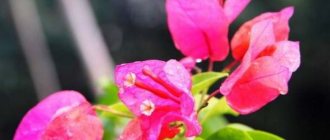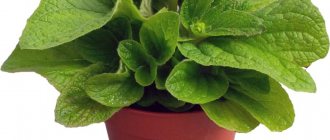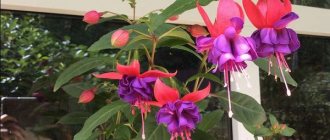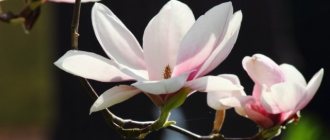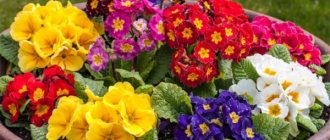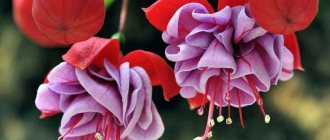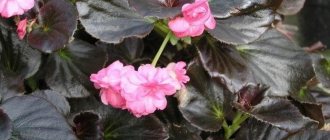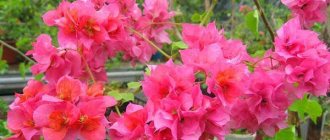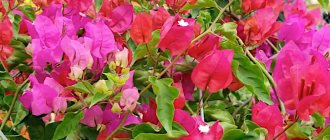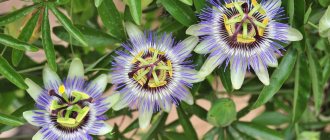Author Ekaterina Toropova
02/14/2019 10:00 (Updated: 05/09/2021 16:52)
Gardening » Trees and shrubs
Bougainvillea is one of the most luxurious, bright, like summer itself, plants that decorate the cities of the warm southern seas almost all year round. How you want to take with you from your next vacation not only a set of souvenirs, but also this beautiful flower, its memorable sweet aroma!
And although the plant can bloom on an ongoing basis only on the Black Sea coast and in the Crimea, Russian gardening scientists guarantee the cultivation of bougainvillea in central Russia, but subject to mandatory compliance with the conditions of cultivation and care.
Bougainvillea is botanically classified as an evergreen climbing shrub, sometimes classified as a type of vine due to its climbing shoots.
There are three main types of bougainvillea:
- Beautiful - grows up to 15 meters in height, with velvet petals;
- Naked - cultivated as a houseplant, with smooth leaves, no more than five meters in height;
- Peruvian - blooms often and profusely, but is not very common in gardening because it requires very meticulous care.
When growing bougainvillea in the middle zone, the preferred option is to plant the plant in a tub, winter it indoors, and only when warm weather sets in can it be taken outside in the summer.
Climatic conditions for the growth of bougainvillea
A small tree, shrub, vine with thorns - this is a description of bougainvillea.
In its homeland in Brazil, the plant blooms 9 months a year. Flowers and bracts are not decorative. They have different shapes, large, bright, from lilac to white. Behind the riot of color, as if made of paper, the leaves are sometimes not visible. Of the 18 existing species, it was possible to acclimatize and obtain hybrids from several varieties of bougainvillea:
- beautiful;
- Peruvian;
- naked.
The plant loves space, a lot of light and warmth.
Moreover, temperatures below +5 0 C are unacceptable for the roots of the plant. A drop in temperature to 0, even for a short time, is disastrous for a guest from the tropics. Where in the vastness of the motherland can a plant survive in natural conditions? Only in the southernmost latitudes of Crimea, on the Black Sea coast. There, in natural conditions, you can admire the beauty of bougainvillea vines and bushes, garden planting and care in landscape design. In other regions, potted cultivation is used for decoration with removal to the garden for summer maintenance. You can create compositions in winter gardens and greenhouses. But this is a protected ground with a controlled climate.
Bougainvillea in the Moscow region gratefully accepts relocation to fresh air when the threat of return frosts has passed. But the flowering period is short. In September, the plant must be preserved again from cold weather. But the spectacle of a blooming exotic tree makes up for all the difficulties of its maintenance. Sometimes the tub with the plant is buried, and then it seems that the tree is growing from the ground.
Planting and caring for bougainvillea in the North-West is carried out only in winter gardens and greenhouses. Keeping potted plants indoors is the only way to admire the beauty of tropical plants. In greenhouses and winter gardens, bougainvillea should occupy the southern side, without crowding.
General idea of bougainvillea culture
A climbing vine from the family. Nociformes, widespread in South America, have also attracted interest from floriculture lovers in Russia. In the natural environment it can be represented by different life forms: liana, shrub or small tree. More often it is a shrub with clinging shoots. Due to the thorns on the stem, bougainvillea holds onto its support.
The shoots grow very quickly, capable of stretching up to 5 m. The leaf blade is oval, the ends of the leaves are pointed. During the flowering period (from May to November), they are hidden under a screen of bright stipules. Bougainvillea is grown as a large container plant for a winter garden, greenhouse or indoor conditions. In culture, the two most famous species are Bougainvillea glabra (naked) and Bougainvillea spectabilis (wonderful).
The flowers are inconspicuous and inconspicuous; the decorative appearance of the plant is provided by bracts (bacteria), which have a wide variety of colors. There are two-color varieties, as well as varieties that can change color during flowering. The variegated leaves also add decorativeness to the vine. Breeders dream of breeding bougainvillea without thorns and with blue stipules, but so far this is just a dream. Although the few modern varieties in cultivation are amazing.
Bougainvillea requirements for cultivation and care
Depending on the conditions, the vine can grow up to three meters in a year. Regulating growth and flowering becomes an important factor in the decorativeness of garden bougainvillea during planting and care.
Crown formation
Proper pruning of young and skeletal branches allows you to form the desired crown. Any bush shape can be chosen. Without pruning, the number of side shoots decreases and the decorativeness of the plant decreases. There are three types of bougainvillea pruning:
- in the fall, before Bougainvillea retires, the summer growth is shortened by half;
- in spring, branches with lignified stems are shortened by 10-13 cm, causing bushiness;
- During the growing season, weak growth and branches that disturb the composition are removed.
The same is done with potted and greenhouse plants.
Temperature
Even in the most favorable climatic conditions of California and Madrid, the risk of freezing bougainvillea when grown outside remains. Required temperature:
- in summer, during flowering 21-27 0 C;
- the beginning of the growing season in spring at temperatures above 10 0 C;
- The minimum temperature of the earth's coma is +5 degrees.
If the plant is kept in warmer conditions in winter, there will be no dormancy period, but summer flowering will be weaker. It is important for areas where the plant is displayed in tubs for the summer to follow a regime for a summer riot of color.
Pruning and bonsai
Bougainvillea is a popular plant for bonsai, it allows you to get any shape of a bush and gratefully responds to pruning with lush flowering. Trimming to stimulate flowering is also recommended for large plants. Bougainvillea itself does not form a crown; it has long shoots, and from a distance the plant without formation resembles a hanging one.
Types of pruning:
- Before the period of winter dormancy , in the fall the branches are shortened by half.
- Spring pruning : remove 10-13 cm for better tillering.
- Periodic : as necessary, weak shoots or shoots that interfere with the crown are cut out in the summer. Also, faded shoots are regularly shortened, leaving shoots of 4-6 buds - this way you can stimulate repeat flowering in the same season.
Summer pruning.
Young shoots are pruned, no older than 3-4 years; lignified ones should not be touched - this makes no sense, new buds on such branches almost never awaken. Although lignified shoots are successfully pruned when forming a bonsai.
Shapes that can be created from bougainvillea:
- Ampelnaya.
- Bush.
- Standard
- Bonsai.
Of these, the most complex are standard and bonsai - their formation will take several years. The ampelous form is relatively simple, the plant is planted in a suitable container, hanging shoots are trimmed as necessary. Bougainvillea is also often guided along supports for hanging plants, while maintaining a long central trunk.
In the photo there is a bare Bougainvillea bonsai - Bougainvillea glabra
Factors to consider when growing and caring for bougainvillea
The plant needs abundant watering with warm, soft water. At the same time, waterlogging should not be allowed. Soggy soil, especially cold soil, will lead to root rot and plant death.
In summer, watering depends on the daytime temperature; it is carried out in the morning no more than twice a week when growing bougainvillea outside. Spraying the green leaves is beneficial to the plant, but the bracts must remain dry. In winter, watering is rare, only to slightly retain moisture in the earth. You cannot overwater the plant.
If bougainvillea in the Moscow region is kept in a container, replanting is performed when growth is reduced, which means the roots do not have enough nutrition.
It is necessary to feed the plants during the growing season with a complex fertilizer; in the spring it is effective to use mullein. Excess nitrogen fertilizers can provoke an increase in green mass to the detriment of flowering.
The plant needs diffused light in winter and bright, long days in summer. Direct sunlight is beneficial for bougainvillea, as is bright diffused light. For good flowering, at least 6 hours of direct light is required.
When planting a tub plant, it is necessary to take into account not only the lighting, but also choose a windless place. In drafts, the plant may shed its leaves. The tub must be installed once; you cannot even turn it, changing the direction of the branches. The plant will stop blooming and drop its leaves.
If the weather has turned bad and, according to forecasts, prolonged bad weather is expected, bougainvillea must be protected from waterlogging by all available means.
Problems during cultivation
The plant is losing leaves
The most common problem is the falling of leaves or bright bracts (which, we repeat, are often mistaken for flowers, but are still closer in nature to leaves). Causes:
- Change of place, relocation of a flower from the fresh air (store, nursery) to an apartment.
- Change in room temperature.
- Change in humidity in the room.
If points 2 and 3 have changed, but within the normal limits for bougainvillea, then it acclimatizes quite quickly, however, this does not always happen, and here again an analysis of the reasons is necessary. Look what exactly has changed:
- It has become drier or the air temperature has risen, but watering remains the same - the plant lacks moisture.
- It has become more humid, but the watering has not changed - there is a risk of flooding the plant.
It is not difficult to distinguish a flooded plant from a drying one; the leaves of the former turn yellow and wither, falling off as if reluctantly; if the plant does not have enough watering, the leaves dry out, including those at the petiole, and fall off easily. If the green leaves fall off, then the bougainvillea does not have enough nutrition and needs feeding.
Plants placed on an open balcony or loggia in the summer are especially at risk. In the middle zone, the difference in daily temperatures may be too large.
Another negative factor is contrasting air flows . The plant loves even, soft warmth without changes. A draft or a flow of dry air from heating vents is a common cause of leaf loss and the formation of defective leaves and bracts.
Pests are another possible cause of leaf drop. It is not always possible to detect them immediately, but a careful examination will allow you to make an unambiguous diagnosis.
Bougainvillea can be affected by:
- In the rooms there is a spider key.
- In open ground: scale insects, aphids, whiteflies.
Variety "Scarlet O'Hara", formed by a trunk.
Why doesn't the plant bloom?
This is the second most common problem - bougainvillea grows well, but does not bloom, or the flowering is too poor .
Causes:
- The plant is fattening. Bougainvillea is one of those plants that requires a tight container for lush flowering, otherwise it begins to go “into the tops.”
- Cool and damp during summer maintenance. For example, if the bougainvillea is standing outside and is constantly “attacked” by rain, and the summer turns out to be cool.
- Lack of a rest period, or an incorrectly organized rest period . The temperature for setting buds should not exceed 10–12 °C, otherwise you should not expect abundant flowers. Sometimes a simple technique can stimulate the flowering of bougainvillea - artificial rest for 2-4 weeks. For this period, watering is limited (watered only after the top layer of soil has dried) and fertilizing is completely eliminated. As soon as young shoots with new buds are formed, the “diet” is stopped.
Creating man-made beauty with bougainvillea
An individual specimen of a tropical flower can last from one to 10 years under cultivated conditions. Bougainvillea reaches its maximum decorative value at the age of 4-5 years. The bushes planted in the soil of the greenhouse on the south side are especially beautiful. In summer they turn into flower avalanches. Compositions that include different colors are especially beautiful.
There is another way to use the effect of a single bush with different flowers.
Initially, several plants are planted in one tub, an intertwined trunk of several vines and a lush multi-colored bush are formed by pruning bougainvillea .
Unusual and fascinating with mystery, bonsai from naked bougainvillea. This variety lends itself perfectly to the formation of a standard. Arches made of vines, pergolas, gazebos, whatever the skillful hands of an artist can make from living material!
How to grow bougainvillea - video
Bougainvillea in the middle zone - why not. Yes!
Bougainvillea is one of the most luxurious, bright, like summer itself, plants that decorate the cities of the warm southern seas almost all year round. How you want to take with you from your next vacation not only a set of souvenirs, but also this beautiful flower, its memorable sweet aroma!
And although the plant can bloom on an ongoing basis only on the Black Sea coast and in the Crimea, Russian gardening scientists guarantee the cultivation of bougainvillea in central Russia, but subject to mandatory compliance with the conditions of cultivation and care.
Bougainvillea is botanically classified as an evergreen climbing shrub, sometimes classified as a type of vine due to its climbing shoots. There are three main types of bougainvillea:
– Beautiful – grows up to 15 meters in height, with velvet petals;
- Naked - cultivated as a houseplant, with smooth leaves, no more than five meters in height;
— Peruvian - blooms often and profusely, but is not very common in gardening, since it requires very meticulous care.
When growing bougainvillea in the middle zone, the preferred option is to plant the plant in a tub, winter it indoors, and only when warm weather sets in can it be taken outside in the summer.
1.Seven secrets of success:
| 1. Growing temperature: summer - 18 - 24 ° C, winter - it is advisable to provide a cool dormant period at a temperature of 10 - 13 ° C. The plant should not be exposed to temperatures below 7 ° C. |
| 2. Lighting: Brightly lit location, bougainvillea should receive sunbath in the morning and evening daily. |
| 3. Watering and air humidity: water with warm water during spring and summer in such a way as to dry out a 2-3 cm thick layer of soil between them. In autumn, watering is reduced and in winter it protects the soil from completely drying out. Air humidity is increased only to prevent invasions of harmful insects. |
| 4. Pruning: formative pruning in the fall to maintain a beautiful shape, sanitary pruning as necessary. |
| 5. Soil: organic-based, neutral or slightly acidic, nutritious substrate, easily permeable to moisture and air. |
| 6. Feeding: every 2 weeks, bougainvillea is fed with liquid mineral fertilizers in half concentration during the warm season. In the fall, fertilizing is reduced and in winter the plants are put into a dormant period, denying the flower the application of fertilizers. |
| 7. Reproduction: by half-ripe stem cuttings, air layering, grafting, seed method. |
Botanical name: Bougainvillea.
Bougainvillea domestica - family
Origin, where it grows. Brazil.
Description. Bougainvillea is a fast-growing tropical, semi-evergreen vine or shrub from South America with brightly colored bracts surrounding small tubular terminal flowers from early spring to late summer.
Plants have flexible, climbing shoots. Plant stems bear thorns.
The leaves are oblong - lanceolate or ovate, with pubescence, arranged alternately.
The flowering of bougainvillea is not of particular interest - the yellowish flowers do not differ in brightness or size, the eye is attracted by the bright bracts. Large clusters of pink, red, orange or purple bracts are produced primarily in the summer months. Flowering plants are almost completely covered with bright clusters of buds.
When grown indoors, the plant does not produce fruit.
In modern floriculture, there are variegated or variegated plants with white specks on the leaf blades.
Bougainvillea flower - height. Up to 4.5 m without trimming. Can be grown as a bonsai - the height of the plant is regulated by pruning.
The flower develops quickly and in just one season it can add up to 2 - 3 m in height.
Bougainvillea's fiery temperament
Bougainvillea, as befits an exquisite beauty, is very capricious and capricious. The plant loves bright sunny color and frequent watering, spraying and fertilizing.
Does not tolerate drafts. Therefore, the installation of a plant tub indoors or outdoors must be carefully planned. When a stream of cold air appears, the bush drops its flowers.
In addition to not liking drafts, bougainvillea does not tolerate movement in space. Even turning the tub with the plant in the other direction and a slight rearrangement can again lead to the resetting of the flower plumage. Therefore, when choosing a place to place bougainvillea, you need to secure it permanently.
Growing bougainvillea at home
Bougainvillea is a heat-loving representative of the flora, which requires sufficient heat and sunlight to grow. The plant needs warm weather all year round, so it is not recommended to grow a flower in open ground if in winter the air temperature can drop to -5 degrees. Under such conditions the plant will die.
Landing
The light-loving plant is practically not afraid of bright sun; in open ground in regions with hot climates it should be planted in a well-lit area. Quite often, the flower is planted near houses, various buildings, fences and fences, which allows creeping vines to completely cover these objects.
It is important to choose a plot with quality land. It should be loose and quite nutritious. Slightly acidic or neutral soil is preferable. To do this, you can add pine needles to the ground. The plant is planted in holes, the depth of which depends on the seedling. A little sand and mineral fertilizer should be poured into the bottom of the hole. Then the flower is planted. Afterwards, you should water the seedling and fluff up the soil.
To grow a seedling indoors, you need to choose the right container for planting.
The recommended pot volume is one and a half liters. Close conditions will prevent the roots from growing too much, and the bush will be compact in size. There must be holes at the bottom of the container for drainage of liquid. Before pouring the substrate, sand, pebbles or expanded clay must be poured onto the bottom.
When preparing the soil, mix turf and leaf soil and sand in equal proportions. A small amount of expanded clay or small shards is added to the resulting mixture. Having planted a flower in the resulting mixture, you need to water the plant and place the pot in a well-lit place.
Transfer
Bougainvillea tolerates transplantation painfully, taking a long time to adapt to new conditions. It is not advisable to replant the plant too often. A flower that is not yet 3 years old is replanted every year after flowering. More mature specimens require changing the soil and pot once every 3-5 years.
Considering that in its natural environment the plant most often grows on mountain slopes, special attention should be paid to drainage. Its quantity depends on the volume of the pot
The new pot for the plant should be a couple of centimeters larger than the previous one. You should very carefully remove the root system along with the earthen ball. Old soil is removed only if it is already completely depleted or if pests have infested it.
It will also be interesting: Indoor balsam - caring for a flower at home?
Temperature
The shrub reacts extremely sharply to changes in temperature. The flowering period in the native southern regions of bougainvillea is long - from May to November. It is quite difficult to organize similar conditions in the middle zone.
Reducing the temperature in winter should be as gentle as possible. But at the same time, keeping the flower at an artificial “summer” temperature all winter is also not recommended. In this case, the plant will bloom constantly, but weakly, and will not gain the necessary strength for summer splendor. Counting on the summer riot of flowering, in winter bougainvillea needs to ensure a state of sleep and rest. To do this, you need to place the plant in a dimly lit room with a low temperature, but not lower than plus five degrees Celsius at the roots.
Where to place bougainvillea?
In order for a tree-like vine to have a strong trunk, a lush crown and delight with bright flowering, the most important thing is to choose the right place for it. Like a true beauty, she loves bright light, surrounded by which she seems even more charming.
In the summer, bungevillea feels great on balconies, terraces, and in the courtyard among flower beds in a sunny meadow.
In winter, she simply needs warmth and light, so it is best to place the flower on the windowsill or next to it in a room whose windows face south. Being a southern plant that came to us from Colombia, the tree-like vine does not like even slight coolness and drafts and reacts sharply to these phenomena by shedding its leaves. She also does not like it when her location is changed. If you frequently move a flower from place to place, it may stop developing and “freeze” for several months.
Also, the flower does not like it when its shoots try to wrap around the support.
Origin and appearance of the bougainvillea plant
In its homeland in South America, this tropical plant blooms 9 months a year. Gardeners from different countries fell in love with it for its unusual shape. Now it can be found in Europe, Asia and in our country.
Bougainvillea adds special decor to the home, quickly creating flower arches
Note! The plant was named in honor of the French traveler and explorer Louis Antoine de Bougainville.
Description of the flower
In natural conditions, bougainvillea liana clings to natural or artificial supports with creeping branches with thorns, its shoots grow in any direction.
The structure of the inflorescence is interesting: the flowers themselves are small white on a thin long stalk, grouped in 2-3 pieces. Large petals, brightly colored, paper-like, are bracts. They are located very densely and in some places completely obscure the leaves.
The bougainvillea flower looks like the product of a talented needlewoman
Types and varieties
There are 18 wild species found in nature. Three of them have been acclimatized for growing bougainvillea in Russian gardens.
Bougainvillea is beautiful
Her homeland is Brazil. It grows in tropical forests on rocky mountain slopes, gradually weaving them into a dense carpet. In gardening it is used to decorate the walls of houses, fences, and gazebos. The leaves are dense, covered with villi, bracts of various red shades, as they age, they lose their brightness. The inflorescences look like panicles.
Bougainvillea naked
Naked bougainvillea is native to Brazil, but in drier regions. It differs from its “beautiful” relative in the small number of thorns. The leaves are smooth, without hairs and have a sharp tip. The shoots represent a full-fledged vine. The bracts are lilac in natural conditions; breeders have developed varieties of yellow, white, red, and pink colors.
Bougainvillea peruviana
This species is native to Peru and Colombia. This bougainvillea is a loosely branched shrub with short thorns, round leaves and double bracts, red or purple. In gardening, it is recommended to prune it intensively in order to stimulate the growth of side shoots and give the bush fullness.
All 3 species cross well; breeders are developing new varieties of garden bougainvillea with spectacular shapes and colors.
Usage
Garden bougainvillea is suitable for landscaping the walls of a house, gazebos, canopies, and arches. Its shoots tightly entwine the support, the flowering plant looks very impressive and amazes with its beauty.
Read also: Black walnut: beneficial properties and contraindications, use, benefits and harms
In regions with cold climates, the plant is grown in pots, which are taken out into the fresh air in the summer and kept indoors in the winter. Garden bougainvillea is ideal for greenhouses and winter gardens.
Transplantation after acquisition into open ground
A tropical plant in open ground in Russia will grow on the Black Sea coast of the Caucasus and Crimea, provided it is covered for the winter. The most favorable growing temperature is +25 °C. At +5 °C it gets sick, and at 0 °C it dies.
At the latitude of the Moscow region, bougainvillea can be grown and cared for in winter gardens and greenhouses. Another method of cultivation: in the spring it is taken out into the open air, and in the fall it is returned to the house.
What is needed for planting
To make the green pet feel good, it is grown in large tubs and containers. Soil for large potted plants can be purchased at garden supply stores. The soil should be slightly alkaline. Drainage must be placed at the bottom of the container so that the ground allows moisture and air to pass through.
Choosing the optimal location
A resident of the tropics loves bright sunlight; for planting they choose the south side of the plot or house, protected from strong winds.
Step by step planting process
To plant a plant, you need to take a few simple steps:
- Fill the container 1/3 full with drainage.
- Then soil is added to ½ volume.
- Place the seedling.
- Add soil and compact it.
- Water generously.
Note! Experienced gardeners recommend planting several plants of different colors in one large container. Subsequent mixing of the shoots and proper pruning will add charm to the plantings.
Bougainvillea of different colors in one interior adds sun and joy to the owner
Reproduction
Seeds
bougainvillea seeds
They are quite small. They are usually bought; it is difficult to collect seeds at home. Sowing is carried out as follows:
- The seeds are soaked in a growth stimulator (Epin, Zircon).
- Prepare a container filled with a mixture of sand and peat (1:1). It is advisable to disinfect the mixture (for example, in the oven).
- The substrate temperature should be at least 27-30 C, so bottom heating should be organized. Only in the most extreme case, a regular battery can act as a bottom heating, but this is too troublesome and the battery will not provide the required stable temperature. It is best to make a special bottom heating. For example, the network has good options for shoe dryers (heating elements are rubberized, low load on the electrical network).
- The seeds are laid on the surface of the substrate, moistened with a spray bottle, and covered with glass.
- Shoots appear in 2-3 months. Periodically you need to wipe the glass and moisten the surface.
- If the seeds are sown in winter or additional lighting is needed in early spring, it is placed at a distance of 25 cm from the ground.
Shoe dryer with rubberized coating - can be used as a heat source for bottom heating of sown seeds.
One of the bottom heating options is in the video below:
Cuttings
Cuttings are taken during the period of active growth, in spring and summer, lignified shoots (June-August) or green shoots (March-May) are cut off. The lower cut is oblique - 1-2 cm below the bud, the upper cut is made straight above the bud by 1 cm. The lower leaves are removed. The cuts are dried a little, the lower one is treated with a root growth stimulator, for example, Kornevin (although many experienced gardeners claim that if the cutting takes root, it will do so without stimulants). Bougainvillea propagates quite well from cuttings.
The finished cuttings are planted in a sterile soil mixture consisting of leaf humus (2 parts) and quartz (coarse grain) sand (1 part), deepened by 5 cm. The mixture can be different, it is important that it is light, nutritious, loose, moisture-absorbing , but does not allow moisture to stagnate. Make sure the leaves do not touch the soil. Daylight hours for rooting should be at least 12 hours. The planted cuttings must be placed in a greenhouse or covered with plastic bags.
The rooting process lasts 2-3 months, during this period it is necessary to provide the soil with a temperature of 25 C, regular ventilation and moisture. When the roots appear (this will be noticeable by the awakened buds), they begin to gradually accustom the plants to less delicate conditions.
Why is soil sterilization necessary? Actively growing plants create their own microclimate, interacting with microbes and bacteria; rooting cuttings that do not colonize the space around them are not yet capable of this. There is a risk of rotting and death of the cuttings. Although, of course, you should rely on your own experience, some successfully root any plants in any suitable mixture without sterilization.
You can also root cuttings in water, creating the same conditions for the cuttings (humidity + temperature), although this is more difficult. On the other hand, callus formation and the appearance of roots are visible in the water.
By layering
This is the easiest way. Bougainvillea easily produces aerial roots at the nodes, so in open ground it is enough to fix any green twig, after making cuts on its bark, into the ground. A little earth is poured on top, so the cutting receives both nutrition from the mother plant and the opportunity to form roots. After a month and a half, thick roots will form at the site of the cuts, and the cuttings are ready for independent life.
If the plant is indoors, then it can be rooted in plastic cups. Cuts are also made on the selected branch, a hole is made in the plastic cup, and a cut on the side so that the branch can be inserted into it, the cup is secured to the branch (you can use tape), any loose mixture is poured in that retains moisture, but does not allow it to stagnate (you can use the same mixture as for planting the plant, only adding more light loosening components: moss, sawdust, etc.)
Bougainvillea by air layering. True, in this photo the author planned to shorten the too long trunk of a tree formed as a bonsai, but the principle is the same. New shoots form at the site of the cut.
Bougainvillea: how to propagate
Despite all the capriciousness of the plant, solving the problem of how to propagate bougainvillea is not difficult.
Propagation by cuttings
Bougainvillea cuttings are carried out in the spring, when after pruning the bushes there are many shoots left. From the entire mass, lignified ones are isolated and cut into pieces of 10-15 cm, always under the bud. The cuttings should have 3-4 healthy leaves.
The prepared material is placed in settled warm water. After a few hours, it is treated with a drug that stimulates plant growth. The lower 2 leaves are cut off and placed in a mixture of peat and sand, immersed to the 2nd internode (the growth point of the third leaf from the bottom). After this, the cuttings are watered abundantly and a mini-greenhouse is arranged, covering each cutting with a large jar or securing covering material over them.
Note! Planting is carried out indoors at a temperature of +25 °C.
Every subsequent day the structure is opened, ventilated and the branches are sprayed. Rooting occurs within a month, after which the new bougainvillea is taken outside for permanent residence.
Bougainvillea cuttings will turn into full-fledged vines next season
Growing from seeds
Fruits are selected from good healthy bushes. The pods are hidden inside dried bracts. They ripen in late autumn, so the whole process takes place in winter.
The soil is prepared from garden soil, sand and peat (ratio 2:1:1). The extracted seeds are sown in a container at a shallow depth, sprinkled with soil and lightly watered. The container is placed under the film. The optimal temperature for germination is from +25 to +30 °C. To do this, turn on fluorescent lamps at a height of 25 cm from the soil level.
Light watering is carried out as the soil dries while simultaneously ventilating it. Seedlings appear after 2-3 months. The illumination is left even after the emergence of seedlings.
Note! Bougainvillea reproduces by layering only with constant cultivation in open ground.
Choosing a place and landing
In order for Bougainvillea to develop well and bloom profusely on the street or in the garden, it needs to be provided with conditions as close as possible to its usual habitat. Under natural conditions, the heat-loving beauty usually grows on sunny rocky slopes. Therefore, when choosing a location for it, the following factors should be taken into account:
- the planting area should be well lit, protected from the wind, and free from other trees and shrubs;
- the soil on the site should be well aerated, drained, dense, neutral or slightly alkaline.
If garden soil for Bougainvillea does not meet these criteria, you can buy it in a specialized store or mix it yourself, from equal proportions of peat, turf soil, sand and humus.
Bougainvillea is planted in open ground in the spring, when stable warm weather is established outside, by cuttings or bushes, in pre-prepared holes. Before planting a plant, you need to make sure that their depth is sufficient so that a drainage layer can be laid on the bottom. Soil mixed with humus is poured onto the drainage and a seedling is placed. The soil around it needs to be lightly compacted and then watered abundantly.
Bougainvillea: care and maintenance in open ground
After wintering, the plants are transferred to outdoor mode, at an average daily temperature above +10 °C. Bougainvillea begins to grow actively, the lashes stretch up to 3 m in length. The main care and maintenance of bougainvillea in the open ground consists of timely watering and pruning.
Watering mode
Water bougainvillea in the garden in the mornings generously 2 times a week with settled water heated in the sun. In hot weather, spray the leaves daily.
With a lack of moisture, the plant sheds green leaves; with excess and stagnation, the foliage first turns yellow and then falls off.
Note! Spraying does not affect the bracts; they are left dry.
During periods of prolonged rains and cold weather, the plant is protected with film. The optimal daytime temperature for flowering is from +21 to +25.
Top dressing
Fertilize young plants once a week, older ones - once every 2 weeks with a complex fertilizer containing nitrogen and phosphorus. What to feed an adult bougainvillea for flowering depends on what is on hand. It is best to fertilize it with a composition containing potassium, phosphorus and iron once every 2 months. Before each planting procedure, pre-water.
Reproduction of garden Bougainvillea
Bougainvillea garden is propagated in three ways: layering, cuttings and seeds. Moreover, the most effective of them are the first two.
By layering
When propagating using layering, a young, low-lying shoot is selected. You need to make circular notches on it, bend it low to the ground and fix it in this position. With this method, regular and abundant watering of both the mother bush and the cuttings is recommended. You can separate the new plant from the mother plant immediately after rooting or next spring.
Cuttings
Cuttings from Bougainvillea garden are cut in late spring or early summer. You can take those that remain after formative pruning, but they must be lignified. The cut is made under the kidney. The shoots are cut into several pieces of 10-15 cm with 3-4 leaves, placed in settled water at room temperature for several hours, and then treated with a growth stimulator. After processing, the leaves, which should be located at the bottom of each cutting, are cut off. Each cutting is placed in a substrate of peat and sand, sunk into the ground up to the second internode, watered and covered with a jar or a mini-greenhouse is built. The room temperature must be maintained at 25 °C. Watering is no longer carried out, but the cuttings are ventilated and sprayed with water daily. A month later, when the roots have grown, it is planted in a permanent place.
Seeds
This is the most labor-intensive and time-consuming method. The seeds are found in pods inside dried bracts. They can only be collected from large, well-rooted plants. To obtain seedlings, seeds are sown in moist soil poured into a container from garden soil, peat and sand in a ratio of 2:1:1. A mini-greenhouse is best suited for germination. If it is not there, the soil is covered with film. From time to time, the substrate with seeds is slightly moistened. After the shoots appear and before they are picked, the film is opened for ventilation.
Features of care during the flowering period
The first step is proper pruning of bougainvillea:
- In spring, the branches are shortened by 10-13 cm for rapid growth of side shoots. The plant will become voluminous. The current year's growth is trimmed lightly, since it is this that produces new buds.
- In summer, drying flowers, leaves and shoots that violate the planned shape are removed.
For bougainvillea in the garden, you can create special supports of original shapes from wire, willow or bamboo. The climbing bush will gladly fill them.
You can turn bougainvillea into a tree: a cutting is attached to a frame of a given shape. When it grows to the expected crown, the growth point is pinched, the lower side shoots are removed completely, leaving only the upper ones. The formation of the bougainvillea crown takes several years until the main trunk and skeletal branches become woody.
Plants are transplanted into a larger container with a significant reduction in fresh growth.
